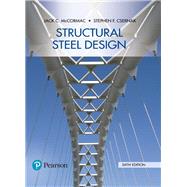For undergraduate courses in Steel Design.
This best selling text has been fully updated to conform to the latest American Manual of Steel Construction. The material is presented in an easy-to-read student-friendly style.
- Both Load and Resistance Factor Design (LRFD) and Allowable Stress Design (ASD) methods of designing steel structures are presented throughout the book. The book is carefully designed so that an instructor can easily teach LRFD or ASD (material exclusively pertaining to ASD is shaded).
- This text is presented using an easy-to-read, student-friendly style.











